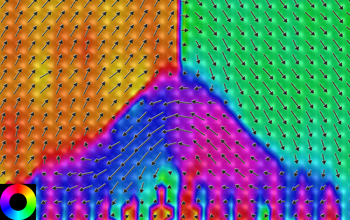Multimedia Gallery
Mapping Polarization of Ferroelectric Materials
At the atomic scale, engineering researchers at the University of Michigan (U-M) have for the first time, mapped the polarization of a cutting-edge material for memory chips. The researchers found a way to improve the performance of ferroelectric materials.
To learn more about this research, which was funded in part by a grant from the National Science Foundation (DMR 07-23032), see the U-M news story Fundamental discovery could lead to better memory chips. (Date of Image: November 2010)
Credit: Chris Nelson and Xiaoqing Pan, Department of Materials Science and Engineering, University of Michigan
See other images like this on your iPhone or iPad download NSF Science Zone on the Apple App Store.
Images and other media in the National Science Foundation Multimedia Gallery are available for use in print and electronic material by NSF employees, members of the media, university staff, teachers and the general public. All media in the gallery are intended for personal, educational and nonprofit/non-commercial use only.
Images credited to the National Science Foundation, a federal agency, are in the public domain. The images were created by employees of the United States Government as part of their official duties or prepared by contractors as "works for hire" for NSF. You may freely use NSF-credited images and, at your discretion, credit NSF with a "Courtesy: National Science Foundation" notation.
Additional information about general usage can be found in Conditions.
Also Available:
Download the high-resolution JPG version of the image. (3.9 MB)
Use your mouse to right-click (Mac users may need to Ctrl-click) the link above and choose the option that will save the file or target to your computer.

